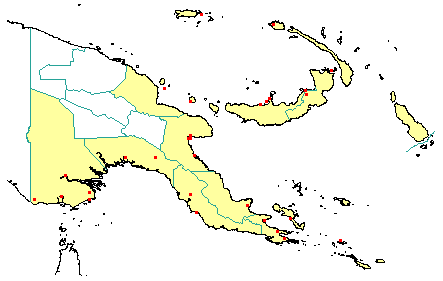
in PNGplants database
PNGTreesKey – Heritiera littoralis Aiton |
Barry Conn (NSW) & Kipiro Damas (LAE).
Guide to trees of Papua New Guinea
Copyright held by the authors, National Herbarium of New South Wales, and Papua New Guinea National Herbarium
Hortus Kewensis Vol. 3: 546 (1789)
Family: Malvaceae
Dicotyledon
Timber Group: Commercial hardwood
Field Characters: Small sub-canopy tree or Large canopy tree (up to 30 m high); Bole cylindrical (up to c. 40 cm diam.); crooked (and leaning) or straight (bole 5-15 m long or trunk branching from near base); buttresses buttresses present (buttresses up to c. 1 m high); spines spines absent; aerial roots aerial roots absent; stilt roots stilt roots absent; Bark grey or brown, rough or smooth, fissured; Subrhytidome (under-bark) green or pale brown; less than 25 mm thick, 9.0-20.0; bark blaze consisting of one layer; faintly to non-aromatic; outer blaze yellow (pale (straw-coloured), pale brown, or pink, with stripes (cream-coloured), fibrous; inner blaze white (often (next to sapwood), pink, or pale brown, with stripes (cream-coloured), fibrous; bark exudate (sap) absent; terminal buds not enclosed by leaves.
Indumentum: Complex hairs present (dense), disk-shaped (peltate) (silvery, grey-green scales); stinging hairs absent; mature twig indumentum (hairs) present (scales), hairs dense.
Leaves: Leaves spaced along branches, spiral (leaves occurring singly at a node and arranged spirally up the branchlet), simple (a leaf composed of a single blade); petiole present, not winged, attached to base of leaf blade, not swollen; leaves broadest at or near middle, (12.0-) 14.0-20.0 cm, 6.0-14.0 cm; symmetric (to very slightly asymmetric), entire, not dissected or lobed, obtuse, venation pinnate, secondary veins open, prominent, intramarginal veins absent; leaves lower surface grey, pale green, or white (greenish (dull), upper surface green or dark green (glossy (to subglossy), indumentum (hairs) present (scales), indumentum (hairs) dense (on lower surface); absent; domatia absent; stipules absent.
Flowers: Inflorescence terminal, flowers on a branched axis, cones absent; flowers bisexual, stalked, flowers with many planes of symmetry, 4.0-6.0 mm long, diameter small (up to10 mm diam.) (c. 5 mm diam.); perianth present, with all sepals and/or petals (hence tepals) similar, inner perianth greenish white; 5, some or partly joined (deeply lobed); stamens 20 (c.), present, joined (forming a staminal tube), free of the perianth; ovary superior, carpels separate (when more than one), locules 5; styles free, 5.
Fruits: Infrutescence arranged on branched axis, fruit 50.0-80.0 mm long, 30.0-(per carpel)-50.0 mm diam., brown, not spiny, non-fleshy (woody), aggregate, dehiscent, follicle; seeds 1-2, about 10 mm long, not winged (although each fruiting carpel ridged to slightly winged, with ridge/wing up to 10 mm long), broad (as wide as long), seed 1-10 mm diam.
Distribution: Madang, Morobe, Western, Gulf, Central, Northern, Milne Bay, Papuan Islands, New Britain, New Ireland, Manus & Bougainville.
 | Botanical records in PNGplants database |
Notes: Notes The genus Heritiera was previously classified in the family Sterculiaceae.